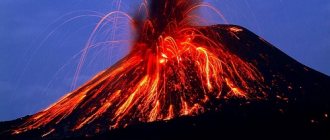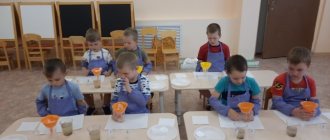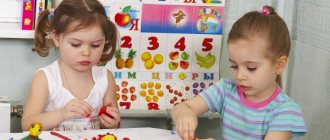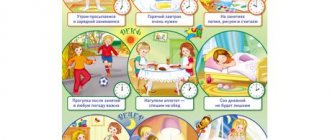Acetic acid and baking soda are inexpensive, accessible products that are widely used in the household.
Photo: Depositphotos.com. Author: ilona75.
They are used in baking confectionery products as a leavening agent or as cleaning agents and detergents that help get rid of scale, grease, lime deposits and stains on clothes.
And with the help of these substances, you can conduct an educational experience for children by making a “real volcano” from soda and vinegar at home.
Lesson “About volcanoes” for children
Experienced teachers have many ways to instill in a preschooler a love of science. These include working in a “children’s laboratory”, conducting scientific experiments, and simple experiments. By independently experimenting with substances and observing physical phenomena, children not only acquire knowledge about the world around them. They learn to think outside the box, exploratively, and can sometimes surprise with their logic.
One of the interesting topics about nature for children is volcanoes. The amazing world of these natural phenomena will not leave any child indifferent. And practical experience under the guidance of a teacher will delight even the most passive students.
Audience: preschoolers 5-6 years old
Props:
- Slides or posters about the structure of volcanoes, books about volcanoes for children, drawing sheets, pencils, markers, paints, brushes.
- Kit for conducting the experiment (basin or deep bowl, jar or bottle, water, cardboard, tape, soda, vinegar, dishwashing detergent, food coloring).
Progress of the lesson
The teacher begins the lesson with a riddle about a volcano:
-I throw stones, lava,
I am a dangerous giant!
Famous for its bad reputation.
What's my name? (Volcano)
- Children, today we will learn a lot of interesting things about volcanoes, what they are made of, how they sleep, erupt, and change the nature around them. In our laboratory we will conduct a magical experiment and see how lava flows out of a volcano, and at the end of the lesson we will have a quiz with questions about volcanoes. Do you love experiments and quizzes? At the end of the lesson, we will also play the game “Volcanologists”.
— What is a volcano? Maybe someone already knows?
This is a large natural mountain with a hole at the top from which hot streams pour out onto the surface of the earth.
— Where did the name Vulcan come from? The ancient people - the Romans - had a God of fire named Vulcan and he lived on the island of Vulcano in a country that is now called Italy. The god Vulcan commanded fire and lightning, and helped blacksmiths use fire to make objects from iron.
Here the teacher draws the attention of preschoolers to slides or posters about the structure of volcanoes.
—What does a volcano consist of? You and I already know that a volcano is a big mountain. It has a hole - a vent, from which hot, red-hot rock - lava - flows. The top of the vent is called a crater. It is located at the very top of the mountain. And below the mountain-volcano there is a huge cave with a hot substance called magma.
— Why do volcanoes erupt? Magma accumulates in the cave, begins to boil, rises up the vent and pours out onto the ground through the crater, turning into lava. Along with the magma, columns of smoke and volcanic ash erupt from the volcano, and hot stones fly. The whole earth around becomes gray and lifeless.
Physical exercise “Volcanic eruption”
- Let's imagine how a volcano erupts! Let's all sit on our haunches or on the floor. We are magma in an underground cave. Now let's start boiling and seething. We will splash our hands in the air and try to jump up. So the volcano is trembling, preparing to erupt. Now let our volcano burst out through the vent. Children jump up and raise their hands up. Magma poured out of the vent through the crater and spread over the ground, becoming lava.
Interesting facts about volcanoes
— And now interesting facts about volcanoes . They are active and dormant (extinct). Active volcanoes are those that have erupted in the last 10 thousand years and may still wake up and spew lava. Sleeping volcanoes will never wake up again. All volcanoes are studied by scientists - volcanologists; they are the ones who make predictions about what will happen next, whether the volcano will erupt or go dormant.
— The largest volcano on the planet, if you count the height from sea level, is Ojos del Salado . Its height is 6887 meters. It is located in South America and is considered dormant and extinct.
— The most dangerous volcano is located in Mexico, it is called Popocatepetl . Can you repeat this word? Volcanologists expect that he will someday wake up and erupt lava. Popocatepetl can kill a lot of people.
— In the Canary Islands there is a volcano on which a restaurant was built, and people cook food right on the fire of the volcano! They grill shish kebab and fish and treat the guests!
Now let's try to make a volcano erupt ourselves!
Children's laboratory experience
The teacher makes a model of the volcano in advance of the lesson or during the lesson with the children.
A basin or tray is placed on the table. This will be an island. The cardboard must be rolled into a cone and the seam sealed with tape or glue. The tip of the cone - cut off the crater with scissors. The cone can be coated with plasticine, so it will look like a real volcano. Place a bottle at the bottom of the basin under the cone, pour a tablespoon of soda into it, and pour in dishwashing detergent (25 ml). You can pour pebbles, sand into a basin around the mountain, and place animal figures. This way the picture will be more realistic.
In a mug, dilute food coloring (can be red or orange) with water and pour everything into a bottle under the volcano with the other ingredients. This way the magma will be ready.
And now the most important thing: pour vinegar into the mouth of the volcano and watch the eruption!
Here the teacher needs to be careful, it is important not to spill the vinegar and not allow the children to inhale this liquid.
Mixed with baking soda and dish soap in a bottle at the base of the volcano, the vinegar will create a rich foam from the volcano that will flow down the mountainside.
If you add baking soda and vinegar, the volcanic eruption can be repeated several times. Children will undoubtedly enjoy the spectacular experience.
After the experiment, it is advisable to ventilate the room.
Quiz
The quiz will help little researchers consolidate their acquired knowledge. Questions:
— Where did the name “volcano” come from?
— Which artisans did the god of fire help?
— What is the name of the hot substance in the cave under the volcano?
— What is the name of the long hole in a volcano through which magma rises?
- What is a crater?
— What does the magma that flows from the crater of a volcano turn into?
— What types of volcanoes are there?
—Who are volcanologists?
— What is the name of the largest volcano on the planet? Such a difficult word...
— What is the name of the most dangerous volcano?
Game "Volcanologists"
The most active participants in the quiz can be nominated as scientists - volcanologists. Let it be a girl and a boy.
Now you need to choose 3 - 4 strong boys who will firmly hold hands and form the mouth of a volcano. Their task is to hold their hands no matter what and not break the circle.
Volcanologists need to fill the volcano with magma. To do this, they call the rest of the participants into the mouth. A girl - a volcanologist - takes other girls by the hands and leads them into a circle - the mouth of a volcano. And the boy, a volcanologist, brings the boys, “pushing” them into the crater.
Circle - the muzzle stands firmly, without unclenching his hands. Children will have a lot of fun climbing into the circle and crowding around there; at this time the volcano is already seething, preparing to explode.
Everyone who did not fit into the crater can be called dinosaurs; they wander around the volcano. As soon as the vent overflowed, everyone who could entered the circle, the magma tore the vent - the volcano erupted, the children jumped out or fell out of the circle onto the floor. It's so fun!
Maybe now volcanologists themselves will choose an assistant and be the vent?
At the end of the lesson, the teacher invites the children to look at books about volcanoes for children with illustrations. Based on the knowledge they have acquired, children can themselves draw a volcano and the process of its eruption, using sheets of paper, paints, felt-tip pens, and pencils.
So, from the drawings in kindergarten, you will get an almost real scientific and educational exhibition about volcanoes for children.
Making a fairytale island
You can build an island in a large plastic container. Pour real water and line the bottom with round pebbles. Make a container for the volcano from a baby food jar or an old glass. For the mountain inside which the container will stand, you need to make a cardboard model; your child will be happy to cover it with plasticine.
The sequence of making a volcanic mountain:
- cut out a circle of the required diameter from thick cardboard;
- make a cut from the edge to the center of the circle;
- roll up a cone;
- the edges of the cone are fastened with a stapler or tape;
- cut off the upper part of the cone at a height equal to the container chosen for the volcano;
- place the container inside the cone.
I coat the top of the mountain with plasticine. To do this, roll out small brown plasticine cakes and stick them to a paper cone, completely covering the cardboard. The top of the volcano can be made of red plasticine, which will imitate hot lava.
They place a volcanic mountain on a dry island of pebbles. They are seated around small rubber animals that are among children's toys. Multi-colored amazing dinosaurs or wolves, foxes, bunnies, bears and other inhabitants of the forest and jungle. Depending on what animals were planted, vegetation for the island is selected. Large tree ferns and horsetails for dinosaurs, and ordinary fir trees and birches for bunnies and foxes.
Plastic plants are also often sold in sets for children's games. You can use a leaf of a living fern and twigs of plants if it is summer outside.
Plants can also be molded from plasticine, made from threads and beads or ordinary cardboard.
You can make small houses out of cardboard for plastic Indians and soldiers. It is better to use cardboard to make plants and houses when the island is in a container with blue-dyed sand instead of water or on a blue plasticine sea.
Precautions when working with chemicals
Important! Any substance, even the most harmless at first glance, can be dangerous if handled incorrectly. The components for the experiments listed are no exception.
To ensure that the “volcano splashing with hissing lava” brings only joy and the fun does not end in trouble, the following precautions must be observed:
- The experiment should only be carried out under adult supervision. Children should not be allowed to experiment with chemicals on their own.
- Before starting the experiment, you should stock up on kitchen towels in order to clean up in time if a caustic liquid spills.
- When working with acid, it is important to prevent it from coming into contact with exposed skin to avoid burns, and if this happens, immediately wash off the liquid with water. You can protect your hands with rubber gloves.
- When there is a “volcanic eruption,” you should not come close to it or lean over the vessels in order to better see what is happening. During boiling, caustic splashes can get on the skin or mucous membrane of the eyes.
- After completing the experiment, you should not leave the used materials; you should immediately drain the remaining liquid into the sink, wash the dishes and put the chemicals out of the reach of children.
Boiling water in a glass
When you don’t have plasticine or a bottle at hand, you can use an ordinary glass to set up the experiment. The child can be told that the water will now boil without exposure to heat.
Recommended for you:
How to make an air freshener and flavoring agent from soda and essential oil with your own hands
To do this you need:
- Cup.
- Lemon acid.
- Sodium bicarbonate.
- Water.
Follow these steps:
- Place the vessel on the tray;
- Add 2 tsp to a glass of water. NAHCO3;
- Add a teaspoon of lemon acid.
Instead of soda, you can add vinegar or citric acid (2.5 tsp of vinegar or citric acid per 500 ml of water).
Then boiling water is obtained. When sodium bicarbonate and citric acid or vinegar come into contact with water, they interact, causing the water to boil.
rushing river
To create a river that will boil you will need:
- Plastic pipe.
- Sodium bicarbonate.
- Vinegar.
- Water.
- Food coloring
Do the following:
- Take a plastic pipe and cut it lengthwise.
- Place a makeshift river bed in the bathtub.
- Mix soda and citric acid in a 2:1 ratio.
- Prepare a vessel with water.
- For added color, you can add food coloring to the water or soda mixture.
- Pour baking soda and vinegar into the channel.
- Gradually add water.
From the actions taken, the water will run and foam. If you close the drain, the bath will be a kind of colored lake.
What is necessary
In order to carry out the experiment, the following components are required:
- acetic or citric acid;
- baking soda;
- water.
It is better to experiment using citric acid, because it does not have such a strong odor and is also safer than vinegar.
The ingredients are taken in the following proportions:
- for 100 ml of water 1 tsp. vinegar, 1 tsp. soda;
- per glass of water 2 tsp. soda, 1 tsp. citric acid.
There are several tricks that will allow you to carry out the reaction more violently and effectively:
- For a more vigorous reaction, regular water can be replaced with carbonated water.
- To add color to the components, you should add gouache or food coloring.
- To make the foam thick, you need to add a drop of detergent to the ingredients.
- You can also add sparkles or sequins for added effect.
colored lava
You can also make many volcanoes with different colored dyes.
To organize the experience you will need:
- Small cups or baby food jars in the amount of 6 pcs.
- Gouache of different colors.
- Sodium bicarbonate.
- Water.
- Vinegar.
- Tray.
The following actions are performed:
- Balls of 6 different colors are rolled out of soda and gouache.
- Place the vessels on a tray.
- Pour vinegar into them.
- Place prepared balls into each vessel.
Recommended for you:
How to clean, cook and boil coins with soda, reviews from people
A colorful violent reaction will occur. You can also watch how different colors are mixed on a tray.
Experience . Boiling Lake
You need to use your imagination, imagining that a bowl of water is a huge body of water and tell your child about it. Children are dreamers and can easily be drawn into play. For the experiment you will need:
- Dishes.
- Soda.
- Vinegar or citric acid.
How to make a “boiling” lake:
- Add a little soda and citric acid to the water and the pond will begin to bubble.
- Give your child the opportunity to do it himself - he will like it.
- Throw in the components one at a time, changing their sequence to cause further “boiling” of the liquid.
The boiling lake actually exists. It is located on the territory of Kunashir (Kuril Islands) and is heated by volcanic gases, hence the name of the reservoir. The most interesting thing is that it is connected by an artificial canal to a lake called Goryacheye.
From baking soda
To make the product, you will need: water, vinegar, diluted food coloring, dishwashing detergent, baking soda.
Procedure for creating a volcano:
- To begin, take about a glass of baking soda and add three tablespoons of water to it, thus obtaining a mixture for sculpting a volcano. If you want to make a big volcano, then add more water.
- Mix the baking soda well and make a mountain. Let it dry, this will take some time, about 3-4 hours.
- Then color the craft with food coloring.
- Place the product on the container, add a little vinegar, about a teaspoon and a tablespoon of detergent. As a result, foam and hissing will pour out of the volcano.
Small tips
When creating woodcan at home, use your imagination. Here are some tips:
- If desired, color the product.
- Add the ingredients carefully to avoid messing anything up.
- To enhance the eruption, add mints and soda.
- Be sure to wear goggles and gloves.
As you can see, making a volcano at home is simple and fun. The product will give an unforgettable experience to both children and adults. Making a volcano can be combined with a geography or chemistry lesson for children, and adults will simply have a good time doing this activity.
Originally posted 2018-08-29 09:26:24.




